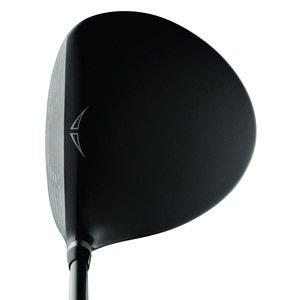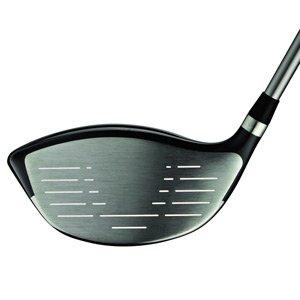Ever wish you could take only the best qualities from ‘x’ and ‘y’ to make ‘z?’ Especially when it comes to golf clubs? Well a company did just that for you this year. PING’s new G20 driver combines the best qualities from two of their drivers from last season, the K15 and G15. PING has a staunch following that borders on fanaticism yet they always offer clubs that may look ‘plain’ or ‘boring’ but lately their designs are slowly emerging from those shells while still maintaining their core values. If you’re interested in long, forgiving, powerful, and straight driver then you may want to read on because these are all qualities that have been taken from two previous drivers and put into one nice and neat package. This all sounds good but do these qualities work or is it an experiment gone wrong? Check it out.
From the Company
- High launch/low spin characteristics maximize distance and accuracy
- Club head is made from a Ti 8-1-1 lighter low density alloy for high strength to weight ratio
- Additional weight is strategically placed around the horizontal and vertical axis to increase MOI
- Variable wall thickness on face and crown
- High balance point shaft allows you to swing more weight/mass at the same speed
Look
When the G20 first arrived to THP I couldn’t wait to open the box. For a company that doesn’t saturate you with marketing, PING managed to provide some subtle buzz leading up to this club’s release and once I opened the box I saw that the subtle buzz was well justified. Holding the G20 in your hand makes you just stare at the club in wonderment. You notice a powerful yet elegant shape made of titanium that just wants you to unleash it on some poor unsuspecting golf ball. Sure the profile is large and slightly elongated (460cc) but it’s not huge where you feel like you’re swinging a small SUV on a stick. When you first waggle the club you feel that the balance and weighting is perfect which is due to the shaft being weighted slightly above its center while maintaining the feel and weight of the club head. Although the external weight has been moved from the heel to the back of the club you barely notice it at address. I’ll touch on the shaft a little later but in terms of looks it’s very similar to what was offered last year in the G15 and the K15 and meshes well with the overall look of the G20.
Technology
That poor golf ball has no idea what’s in store for it when the large face of the G20 smacks it with its variable wall thickness construction. The club face combined with the external weight found on the heel of the K15 driver is now placed directly behind the face of the G20 which means that the poor golf ball will get up in the air faster for you. The aerodynamic shape, or at least as aerodynamic as 460cc can be, combined with the variable wall thickness, the shaft that comes with the G20, and the external weight is really a nice package that is designed to help the golfer get the ball airborne and fast.
Now about that shaft. The TFC 169D is a soft tipped shaft that is almost 46” long (45.75 to be precise) but there’s something different about it this year compared to last year’s stock offering found in the G15 and K15. That difference is the addition of some weight above the center point of the shaft. You may not notice it unless you’re looking for it but I noticed this difference and it didn’t feel overly heavy. In fact it almost felt like a fulcrum for the club when you slowly swing it so I can see how this weighting is designed to help swing the club. The Tour version of the shaft that is also available has a slightly stiffer tip which will launch the ball a little lower with even less spin and will weigh about 6-9g more depending on what flex option you go with.
While it may not be true ‘technology’, I love everything about the stock grip on the G20. In my estimation, PING makes some of the best stock grips in the industry. I’m very picky, if not weird, when it comes to the feeling I like and want from my grips and the grip that’s found on the G20 is one of the few that I would not change and would put into play right away. It’s got a great texture to it that is slightly rough but not overly so.
One other non-true ‘technology’ item that the G20 has that I like is the design of the head cover. Sometimes a bad head cover design can take away some nice feelings one may have for a driver but this one isn’t of that design. While putting it on can sometimes feel like trying to fit a size 12 foot into a size 10 sock, taking off the head cover is a snap due to an ingenious handle that you can take hold of and pull the cover off with a simple tug.
Testing
The G20 I received from PING for testing had a 9.5* loft and a stiff flex shaft (58g) and it was tested in almost every condition possible. Sunny, dry, wet, overcast, breezy, and cool all got their turn at interacting with the G20 so I think as far as elements go, this driver was exposed to everything but rain. It did experience some sprinkles but with the wet conditions that have been a part of NE weather the past few weeks it may have well been in rain-like conditions.
That being said, the G20 performed well in all of these conditions. The design of the club is one that is supposed to give you high launch with low spin which should result in greater accuracy. I found the ball flight to be middle-high with a piercing trajectory. This came in handy with the breezy conditions I mentioned before. You don’t just hit the ball with the G20, you beat the ball. When the ball meets the club face you can feel the ball almost spring off the face however the face isn’t ‘hot.’ The variable wall thickness of the face really gets the ball moving in a hurry while the weight at the back of the club face gets the ball up in the air quick.
One thing about the G20 is that it is a consistent club that doesn’t hide or enhance a bad shot. The ball pretty much goes where the club face is pointing. If you leave it open a bit, which is my most common miss, you get a straight block. Keep it closed and you get a pull. Centered? Oh my does the ball go far. When the club face wasn’t centered I still found my misses to be playable. The shots were long but thanks to the low spin factor you didn’t see wild slices or insane hooks that you may see with some other clubs. When the club face was centered the fairway was more or less a landing strip for the ball as it would fall out of the sky and get some good roll with it before stopping in the fairway. At least when I tested it on dry fairways. Wet fairways tended to stop the ball within a foot or two of its landing but I suspect this would happen with most drivers anyway.
Along the lines of consistency, when you hit the sweet spot of the large face of the G20, you’re rewarded with a unique sound. It’s not like the traditional PING ‘ping’ but more of a ‘crack’ mixed with the ‘ping.’ I’ve described it as a ‘thwack’ before but it’s more of a ‘pinging crack’ which is something you need to hear for yourself. As long as you’re near the center of the face you’re going to hear some iteration of this sound but when you catch it on the screws? You know it and the best part is that you want to hear it again and again. This makes the PING G20 slightly addictive but in a good way. I found my most consistent miss to be a block or a push. While the shaft is the same length as the shaft of the K15 that I tested last year, I found that my swing had to be more consistent with the G20 and that you can’t fully go after a shot. This may be due to the placement of weight above the center point of the shaft which could be problematic in helping get the club head squared at impact if you don’t have a consistent swing. I think the best tempo to unleash the full potential of this driver is one that is medium-fast tempo, or an 8 on a scale of 1-10.
For a low spin driver I found the overall forgiveness to be surprisingly good. The tall face, elongated club head, and 460cc design really helps you hit the ball well and does help with some off-center hits. Unless you blatantly miss-hit the ball, this club will help keep you in lay as much as possible. I found hits off the toe to be straight with minimal distance loss however hits off the heel was where I noticed some distance loss. The G20 may not be the perfect panacea for helping you with your driving problems but it sure will try to as long as you give it something to work with.
Overall
The PING G20 driver is a contender for a full time spot in my bag. It still has some work to do, as do I, but this driver makes it worth putting time in on the range and on the course. Although I’m generally not a fan of the stock shaft for myself and my game, I think for the most part it will be fine for the majority of golfers out there. I wish PING would join the movement by other companies who are including upgraded stock shafts as a part of their stock club offering. I understand why PING doesn’t do this as they firmly believe in their fitting system but for how long before PING fans begin to slowly take their loyalty, and more importantly, their money to other options? Aside from that, there’s not much to complain about with the G20 driver. It retails for $299 and is definitely worth a few swings at your favorite golf store or pro shop if you’re in the market for a new driver. The performance and potential of this driver are hard to ignore so don’t. Once you master it, you, and everyone else will know about the sound this driver makes when you hit it flush. That alone is worth the price once you experience that. For more information about PING and other PING products you can check out www.ping.com.
T. Hanks
















Great writeup Hanks! Glad to see you love this driver, it sounds awesome!
Good stuff Hanks, this will be on my testing list when I change out the driver. I need the high launch it offers.
Great review Hanks! It was very informative. I liked hearing that the low spin aspect of the driver was really working as you were seeing a block on mishits instead of a big slice.
Great writeup! As a K15 user, I will more than likely be putting one of these in the bag. at least as a demo in 2012. I agree on your thoughts on the shaft options. Sooner or later they need to follow the other OEM’s in this area. I would also like to see them come current with adjustable options at some point.
Nice writeup Todd. Like you, I wish PING had a little better fitting system to help you find the right shaft. I also wish they would offer better stock options. Sounds like anyone who is looking for a tall faced driver should have this on their list to demo.
Great review Hanks! That says a lot when it has a chance for the full time spot in the bag. I have never been a huge ping fan but wouldnt mind giving this another try
Great job on the review Hanks! I can’t wait to demo this driver. It looks awesome.
Great review. It sounds like a nice driver. One that needs to be tested.
Stout review on a stout driver! I guess I can’t help but ask though bro: is this baby kicking the K15 out of the bag?
That was a great review T! I love how you described the sound, that is not an easy thing to do with just words alone. I can’t wait to experience this club at THP Demo Day in May. You’re also spot on with your comments regarding the shaft and PING’s decision to stick with what they have always done. They really may regret not having other shaft options available, we’ll see how that one goes in the future.
Excellent review Hanks. Everything you touched on is spot on with my experience with the G20 driver and my G10 will soon be put out to pasture in favor of this rocket launcher
Good write up Todd H. Ive found much the same results using this driver and am quite fond of it.
Really good review Hanks. I see both sides of the argument to keeping their stocks shafts but thats another debate I think! Because its a high launching shaft and low spin, did you notice it get held up by the wind a lot?
This is definitely an exciting driver from PING. I have a feeling it’s going to do really well for them. I like that it seems to mix the best aspects of the G15 and K15. Thanks for the thorough review, Hanks!
Great review Hanks! I love my G15, but from what you have said, I guess I need to give the G20 a try. Thanks for all the great info.
Nice review Hanks…the G20 is definitely I driver I’d like to take a few swings with.
Solid review Hanks! I like the high launch, low spin aspect of this club. Playing a spinny driver right now is making my slices all the worse. This is definitely a driver to look at.
Nice review Hanks!! Gotta ask like TC did – is the G20 going to beat out the K15?
Excellent review. I like that it makes you swing smoothly rather than try to kill the ball.
Good writeup. My driver is about 4-5 years old and I’ve been itching for a new one. The G20 will definitely be one that I test.
Hanks that was a really good review. It sounds like Ping has a winner on their hands. I love how they have created a shaft that allows them to move the balance point up. This is the idea of the Heavy Driver and it looks like other companies are following their lead. I can’t wait to hit this driver.
Good writeup Hanks! as i never really been a fan of ping, i will def go out to hit this driver just to see how it performs for me!
Nice write up ! I love Ping !
Great review, can’t wait to try one myself.
Great review! Your comments make me want to try to test this one out and compare it to my G15 which I really like.
That club is a beauty. And on my short list for drivers to test. Great job on the write up only making that itch get stronger!
Great write up Hanks!! You have me looking forward to getting to swing this big dog.
Ah man. Just when I talked myself out of wanting a new driver and now this. Thanks alot! lol
Wow, Todd, I have to say that I don’t think you’ve done a better job on any previous review. I can’t wait to hear if this does in fact become your gamer driver. I liked the looks of this thing when it was previewed earlier, and it sounds like it lives up to expectations. Keep us informed on this one.
Been waiting for this one and you didn’t disappoint! I totally agree with you about the shaft. If the shaft had a designer name with the same profile willing to wager most people would quiet down a little.
Thanks for the review. I looked at both the G and K15’s last year and liked them both. Maybe this will be the answer for me.
I just played 18 holes today with the G20 side-by-side with my current driver. Once I went in to the pro shop after the front 9 and switched from the 9.5 to the 8.5 head with the Tour D stock stiff shaft, I hit two drives 300-305, then one 312, and one 332! With the STOCK shaft! Great feel, great ball flight, just awesome. I called my pro once I got back in the car and ordered one!
Great review Hank…I have been hitting a demo g15 and k15 for about 2 weeks. I tried the 9.5 and the 10.5 in both. I hit the G15 pretty well, I hit the k15 really well with a slight draw gained about 5 to 10 yards with g15 and a consentent 10 yards with the k15. Today I hit a G20 9.5 with the TFC 169D tour stiff shaft. and I absoloutely loved it. I gained even more yardage. This club gave me much better spin rate (around 2200 to 2600 my spin rate is usually higher around low 3000) with about a 14 degree launch angle, and very little side spin. I will be playing a round with it tomorrow and friday, will update this comment after round. But it looks like this is the driver for me!
I have had 2 of these G20 drivers now. Both drivers after several weeks of use have snapped in half during a big drive. Both times the head of the driver has smashed into my back. Ping reps say this is odd to have happened to me. I say there is a problem with their shafts. They are resifting the latest driver now.
Recently had a custom fitting for a new driver and the G20 with a tour stiff shaft came out tops in all departments, played 2 rounds now and is a fantastic club. Makes you want to swing nice and easy and added 20 yards to my drives (used TM R9 before) and is very forgiving when you dont middle it
The TM R11 is the latest fad but this G20 blew it out of the water for me. Recommended
I hit the TM R-11 last season. the club for me a “16 hcp” was just to hard to find the sweet spot, after looking at tons of reviews about drivers I settled on trying the Ping G-20 Hit it indoors straight 250 to 275 yards but I don’t totally trust the monitors in stores, So I went to my club and they put one together to try, wow what a difference, this bad boy is straight and long, My fairways hit with the TM was about 5 My first 18 holes with the G-20 Ping was 12. Hit the G-20 250 to 260 with one going 300 but the accuracy was very impressive. I could not hit my slice that was prominant With The R-11 Thanks for the review. I highly recomend this driver.
Great review, just tried one of these out today myself and I agree it should be on everyone’s list to try out if they are looking for a new driver.
Not sure what you mean about the stock shafts?? I went to the PING website, looked up the G20 driver, clicked on “custom options” and the G20 is available with (almost) every shaft made. So, am I missing something?? Fred from Mission Hills CC in Rancho Mirage, CA
Just picked up the G20 / Reg Shaft and retired my K15. Love it!
I HAVE A G20 IT IS 12 DEGREES LOFT ,HAS ANYBODY ELSE GOT SAME DEGREES…..IF SO IS IIT DEARER OR CHEAPER………IS FOR LOW HANDICAPPERS
MENT HIGH HANDICAPPERS…………
I am approaching 80 years old but since I got the G20 with 12 degrees my driving has improved 1000%. Must be the shaft.
I just bought one of these drivers. G20 tour stiff shaft 8.5 loft. I had been using the G2 Aldila 6.5 shaft with 8.5 loft, and I know I hit the G2 10 to 20 yards further.The ball just dosen’t jump off the face of the G20 club. I’m naturally disapointed. I thought I was buying new technology and would get a little more distance, but that didn’t happen. Any suggestions? Maybe a different shaft might help. I still like Ping, so I would like some help with this. Thanks, Bill